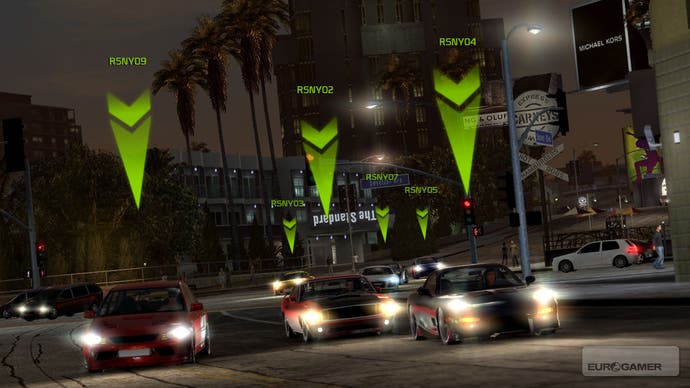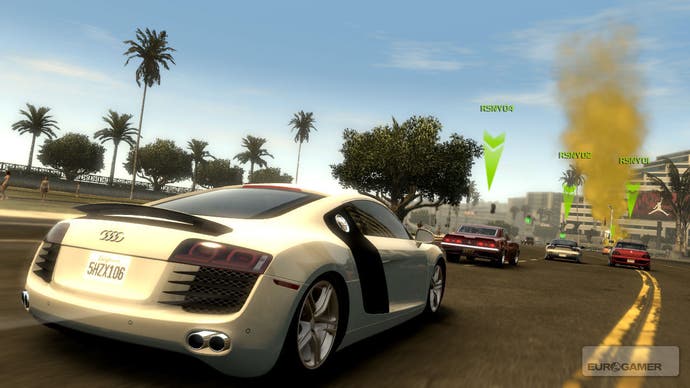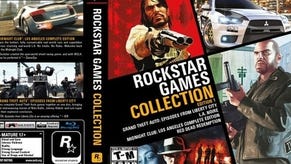Midnight Club: Los Angeles
Speed devils in the city of angels.
We really didn't want to be back at the LA Convention Centre so soon after E3. But this quintessential 1990s corporate boot camp, this never-ending air-conditioned desert of glass, carpet and outsized croissant-wiches has a way of drawing you back, like a terminally confused and overtired moth to a particularly cheerless flame. We must have driven past it five times as we attempted to escape Los Angeles' infernal one-way system on the last day of the show.
At least this time we can do donuts in front of the atrium.
Midnight Club: Los Angeles really gets LA. To be frank, there are more graphically impressive and accurate recreations of real cities in games - most of them in Project Gotham Racing 4 - but there are few more atmospheric ones. The latest Midnight Club has an uncanny handle on the city's soupy air, greasy glamour and sepia-tinted, Scott-brothers sunshine. From the ambling boulevards and untidy beaches of Santa Monica to the boarded-up cracks in Downtown's glossy façade, it's all here, and you can practically smell the suntan oil and smog.
Enough of the virtual tourism; following Tom's recent single-player hands-on preview, we've returned to Rockstar's offices to give Midnight Club: Los Angeles' multiplayer modes a thorough going-over. The mixed party of journalists, PRs and company reps jumps into VW Golf R32s - Eurogamer's assigned colour: hot pink - and starts with an acclimatising Cruise.

Cruise is a free-roaming mode in which a full lobby of players (the game supports 16 in total) can tool around the entire map as they please, drag-racing, screaming along the usually crawling thoroughfares, or jumping straight into races with each other. These Challenge races can be requested from the set options or even created in an online race editor without leaving Cruise. Once a race is triggered, a vertiginous but smooth map zoom transports you from your current spot to the starting line - exactly the kind of seamless integration of multiplayer with free-roaming gaming achieved by Burnout Paradise.
Before we get that far, there's a little time to be spent adjusting to MCLA's handling for this particular Gotham and GRID addict. It's defiantly arcadey, almost Out Run-esque in its progression from fierce grip to graceful, arcing understeer, tipped into savage powerslides by a tap of the handbrake. It's not the most physically involving racing setup out there, but it's not exactly shallow either, and it's pretty well suited to the grids and meandering, monstrous freeways of the host city. Plan your corners early, cut as much pavement as possible, be relatively sparing with the slides and you'll be surprised how little slowing down needs to be done.

To be fair, it's also a little muted by the first two cars we try, both machine-tooled slabs of disciplined, all-wheel-drive Teutonic muscle. The R32 and Audi RS4 are great for feeling out the vagaries of traffic-dodging on the freeway and gently drifting around the twisting residential roads of the Hollywood Hills, but they don't do the best job of bringing Midnight Club's character to the fore. That's best left to the 1970s Dodge Challenger, a gloriously throaty and tail-happy Starsky-and-Hutch-simulator. At the other end of the scale, the frighteningly quick and razor-sharp Lamborghini Gallardo boasts turn-in so quick it's surreal, and inevitably lodges itself at the top of the favourites list as a near-four-hour session draws to a close.
We also get a chance to try bikes for the first time, in the form of a Kawasaki Ninja. It's a reasonable implementation, falling somewhere in between Test Drive Unlimited's balsa-wood rockets and PGR4's meaty but unpredictable machines. In raw speed and handling terms it offers few advantages over the Gallardo, and suffers the usual "touch anything and you're out" fragility of videogame bikes. But MCLA is not a pure circuit racer. Given the Ninja's nimbleness and limited width, traffic and, especially, shortcuts are more easily navigable in the saddle.



